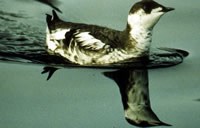
 Injury
Injury
The Kittlitz’s murrelet is found only in Alaska and the Russian Far East. A large percentage of the world population, which may number only a few tens of thousands, breed in Prince William Sound (PWS). The Kenai Peninsula coast, lower Cook Inlet and Kachemak Bay are also important concentration areas for this species.
Seventy-two Kittlitz’s murrelets were positively identified among the bird carcasses recovered after the oil Spill. Nearly 450 more Brachyramphus murrelets were not identified to the species level, and it is reasonable to assume that some of these were Kittlitz’s. In addition, many more murrelets probably were killed by the oil than were actually recovered. Estimates of the total number of Kittlitz’s murrelets that died as a result of the Spill vary from 255-2,000; it has been suggested that this represents 5-10 percent of the world’s population.
Recovery Objective
Kittlitz’s murrelets will have recovered when their population has recovered to a level had the Spill not occurred. Stable or increasing productivity within normal bounds will be an indication that recovery is underway.
Recovery Status
While studies of Kittlitz’s murrelets were conducted in the 2000s, our knowledge of their ecology and trends remains limited. They are known to nest in montane areas historically or actively shaped by glacial action and are thought to reside within PWS from May through August. Nesting has been reported from around the PWS region, as well as the Kenai and Alaska Peninsulas, and Kodiak Island. Kittlitz’s murrelets lay a single egg and have an intrinsically low population growth rate, thus recovery from an acute loss is likely to be slow.
Kittlitz’s murrelets have shown evidence of steep declines, which began before the Spill. The rate of decline between 1972 and 2007 was -18% per year, but if measured between 1989 and 2007, the rate of decline was -31% per year. Estimating population trends for this species is complicated, however, because of the small population size, patchy distribution, and difficulty in distinguishing the rare Kittltiz’s murrelet from the more abundant marbled murrelet. Data from EVOSTC surveys in PWS from 2010 and 2012 suggest a possible stabilization of Kittlitz’s murrelets at a lower population size.
Natural recovery has not restored this resource to levels that would have existed had the Spill not occurred. What little evidence is available from studies in Alaska suggest possible predator limitation in some areas, and lack of productivity due to food availability and chick predation. A 2014 study has also found that paralytic shellfish poisoning has contributed to chick mortality at nest sites on Kodiak Island. While it is likely that basic biological studies would be useful to understand what may be limiting recovery, these confounding effects make it unlikely that further study will clarify whether there are still residual effects of the Spill. In addition, the rarity of this species makes it difficult and expensive to study.
While the population decline appears to have abated, Kittlitz’s murrelets have not met their recovery objective and, due to the factors discussed above, their current recovery status remains unknown.
Click HERE for more information on Trustee Council funded studies of Kittlitz’s murrelet.
